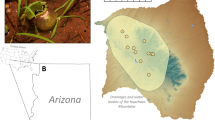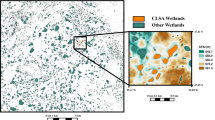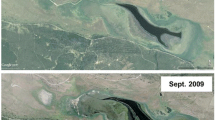Abstract
An individual-based, spatially explicit population model was used to predict the consequences of future land-use alternatives for populations of four amphibian species in two central Iowa (midwest USA) agricultural watersheds. The model included both breeding and upland habitat and incorporated effects of climatic variation and demographic stochasticity. Data requirements of the model include life history characteristics, dispersal behavior, habitat affinities, as well as land use and landcover in geographic information systems databases. Future scenarios were ranked according to change in breeder abundance, saturation, and distribution, compared to baseline conditions. Sensitivity of simulation results to changes in model parameters was also examined. Simulated results suggest that while all four species modeled are likely to persist under present and future scenario conditions, two may be more at risk from future landscape change. Although the study species are all widespread generalists regarded as having a low conservation priority, they depend on wetlands and ponds, increasingly endangered habitats in agricultural landscapes. Broader conservation strategies in the region would ensure that these currently common organisms do not become the endangered species of the future.
Similar content being viewed by others
References
Ashley E.P. and Robinson J.T. 1996. Road mortality of amphibians, reptiles, and other wildlife on the Long Point Causeway, Lake Erie, Ontario. Canadian Field Naturalist 110: 403–412.
Beebee T.J.C. 1996. Ecology and Conservation of Amphibians. Chapman and Hall, New York, New York, USA.
Berrill M., Bertram S. and Pauli B. 1997. Effects of pesticides on amphibian embryos and tadpoles. In: Green D.M. (ed.), Amphibians in Decline: Canadian Studies of a Global Problem. Society for the Study of Amphibians and Reptiles, St. Louis, Missouri, USA, pp. 233–245.
Blair W.F. 1953. Growth, dispersal and age at sexual maturity of the Mexican toad (Bufo valliceps Weigmann). Copeia: 208–212.
Blair W.F. 1957. Changes in vertebrate populations under conditions of drought. Cold Spring Harbor Symposia on Quantitative Biology 22: 273–275.
Blaustein A.R. and Wake D.B. 1990. Declining amphibian populations: A global phenomenon? Trends in Ecology and Evolution 5: 203–204.
Bonin J., DesGranges J.L., Rodrigue J. and Ouellet M. 1997. Anuran species richness in agricultural landscapes of Quebec: Foreseeing long-term results of road call survey. In: Green D.M. (ed.), Amphibians in Decline: Canadian Studies of a Global Problem. Society for the Study of Amphibians and Reptiles, St. Louis, Missouri, USA, pp. 141–149.
Calef G.W. 1973. Natural mortality of tadpoles in a population of Rana aurora. Ecology 54: 741–758.
Casper G.S. 1996. Geographic Distributions of the Amphibians and Reptiles of Wisconsin. Milwaukeee Public Museum Inc., Milwaukee, Wisconsin, USA.
Christiansen J.L. 1981. Population trends among Iowa’s amphibians and reptiles. Proceedings of the Iowa Academy of Sciences 88: 24–27.
Christiansen J.L. 1998. Perspectives on Iowa’s declining amphibians and reptiles. Journal of the Iowa Academy of Science 105: 109–114.
Christiansen J.L. and Bailey R.M. 1991. The salamanders and frogs of Iowa. Nongame Technical Series No. 2. Iowa Department of Natural Resources, Des Moines, Iowa, USA.
Christiansen J.L. and Van Gorp C. 1998. Iowa’s declining amphibians. In: Proceedings of the Midwest Declining Amphibians Conference. DAPTF, Milwaukee, Wisconsin, USA.
Collins J.T. 1993. Amphibians and Reptiles in Kansas. The University of Kansas Museum of Natural History, Lawrence, Kansas, USA.
Dash M.C. and Hota A.K. 1980. Density effects on the survival, growth rate, and metamorphosis of Rana tigrina tadpoles. Ecology 61: 1025–1028.
Diana S.G. and Beasley V.R. 1998. Amphibian toxicology. In: Lannoo M.J. (ed.), Status and Conservation of Midwestern Amphibians. University of Iowa Press, Iowa City, Iowa, USA, pp. 266–276.
Doak D.F. and Mills L.S. 1994. A useful role for theory in conservation. Ecology 75: 615–626.
Dodd C.K. 1993. The cost of living in an unpredictable environment: the ecology of striped newts Notophthalmus perstriatus during a prolonged drought. Copeia: 605–614.
Dodd C.K. and Cade B.S. 1998. Movement patterns and the conservation of amphibians breeding in small, temporary wetlands. Conservation Biology 12: 331–339.
Dole J.W. 1965. Summer movements of adult leopard frogs in northern Michigan. Ecology 46: 236–255.
Douglas M.E. and Monroe B.L. 1981. A comparative study of topographical orientation in Ambystoma (Amphibia: Caudata). Copeia: 460–463.
Dunning J.B., Danielson B.J. and Pulliam H.R. 1992. Ecological processes that affect populations in complex landscapes. Oikos 65: 169–175.
Dunning J.B., Stewart D.J., Danielson B.J., Noon B.R., Root T.L., Lamberson R.H. et al. 1995. Spatially explicit population models: current forms and future uses. Ecological Applications 5: 3–11.
Duvick D.N. and Blasing T.J. 1981. A dendroclimatic reconstruction of annual precipitation amounts in Iowa since 1680. Water Resources Research 17: 1183–1189.
Erlich P.R. 1988. The loss of diversity: Causes and consequences. In: Wilson E.O. (ed.), Biodiversity. National Academy of Sciences, Washington, DC, USA, pp. 21–27.
Findlay C.S. and Houlahan J. 1997. Anthropogenic correlates of species richness in southeastern Ontario wetlands. Conservation Biology 11: 1000–1009.
Foppen R.P.B., Chardon J.P. and Liefveld W. 2000. Understanding the role of sink patches in source-sink metapopulations: reed warbler in an agricultural landscape. Conservation Biology 14: 1881–1892.
Freemark K. 1995. Assessing effects of agriculture on terrestrial wildlife: developing a hierarchical approach for the US EPA. Landscape and Urban Planning 31: 99–115.
Freemark K. and Smith J. 1995. A landscape retrospective for Walnut Creek, Story County. Technical report to the US EPA.
Friedl T.W., Friedl P. and Klump G.M. 1997. Some aspects of population biology in the European treefrog, Hyla arborea. Herpetologica 53: 321–330.
Gibbs J.P. 1993. Importance of small wetlands for the persistence of local populations of wetland-associated animals. Wetlands 13: 25–31.
Gibbs J.P. 1998. Amphibian movements in response to forest edges, roads, and streambeds in southern New England. Journal of Wildlife Management 62: 584–589.
Halley J.M., Oldham R.S. and Arntzen J.W. 1996. Predicting the persistence of amphibian populations with the help of a spatial model. Journal of Applied Ecology 33: 455–470.
Harding J.H. 1997. Amphibians and Reptiles of the Great Lakes Region. University of Michigan Press, Ann Arbor, Michigan, USA.
Hecnar S.J. 1997. Amphibian pond communities in southwestern Ontario. In: Green D.M. (ed.), Amphibians in Decline: Canadian Studies of a Global Problem. Society for the Study of Amphibians and Reptiles, St. Louis, Missouri, USA, pp. 1–15.
Hecnar S.J. and M’Closkey R.T. 1997. The effects of predatory fish on amphibian species richness and distribution. Biological Conservation 79: 123–131.
Helgen J., McKinnell R.G. and Gernes M.C. 1998. Investigation of malformed northern leopard frogs in Minnesota. In: Lannoo M.J. (ed.), Status and Conservation of Midwestern Amphibians. University of Iowa Press, Iowa City, Iowa, USA, pp. 288–297.
Herkert J.R. 1991. Prairie birds of Illinois: Population response to two centuries of habitat change. Illinois Natural History Survey Bulletin 34: 393–399.
Illinois Department of Conservation 1995. Gray treefrog. In: NISC DISC Species Information Library, 2nd printing. 2nd edn. National Information Services Corp.
Jameson D.L. 1955. The population dynamics of the cliff frog, Syrrhophus marnocki. American Midland Naturalist 54: 342–381.
Jameson D.L. 1956. Growth, dispersal, and survival of the Pacific tree frog. Copeia: 25–29.
Jameson D.L. 1957. Population structure and homing responses in the Pacific tree frog. Copeia: 221–228.
John-Alder H.B. and Morrin P. 1990. Effects of larval density on jumping ability and stamina in newly metamorphosed Bufo woodhousii fowleri. Copeia: 856–860.
Jørgensen S.E. 1986. Fundamentals of Ecological Modeling. Elsevier, Amsterdam, The Netherlands.
Karl T.R. and Riebsame W.E. 1984. The identification of 10-to 20-year temperature and precipitation fluctuations in the contiguous United States. Journal of Climate and Applied Meteorology 23: 950–966.
Knutson M.G., Sauer J.R., Olsen D.A., Mossman M.J., Hemesath L.M. and Lannoo M.J. 1999. Effects of landscape composition and wetland fragmentation on frog and toad abundance and species richness in Iowa and Wisconsin, USA. Conservation Biology 13: 1437–1446.
Kramer D.C. 1973. Movements of western chorus frogs tagged with Co 60. Journal of Herpetology 7: 231–235.
Kramer D.C. 1974. Home range of the western chorus frog. Journal of Herpetology 8: 245–246.
Kramer D.C. 1978. Viability of the eggs of Pseudacris triseriata. Journal of Herpetology 12: 119–120.
Laan R. and Verboom B. 1990. Effects of pool size and isolation on amphibian communities. Biological Conservation 54: 251–262.
Lannoo M.J., Lang K., Waltz T. and Phillips G.S. 1994. An altered amphibian assemblage: Dickinson County, Iowa, 70 years after Frank Blanchard’s survey. American Midland Naturalist 131: 311–319.
Lehtinen R.M., Galatowitsch S.M. and Tester J.R. 1999. Consequences of habitat loss and fragmentation for wetland amphibian assemblages. Wetlands 19: 1–12.
Leja W.T. 1998. Aquatic habitats in the Midwest: Waiting for amphibian conservation initiatives. In: Lannoo M.J. (ed.), Status and Conservation of Midwestern Amphibians. University of Iowa Press, Iowa City, Iowa, USA, pp. 345–353.
McGarigal K. and Marks B.J. 1994. FRAGSTATS Spatial pattern analysis program for quantifying landscape structure, version 2.0.
McNeeley J.A., Gadgil M., Leveque C. and Redford K. 1995. Human influences on biodiversity. In: Heywood V.A. (ed.), Global Biodiversity Assessment. UNEP, Cambridge University Press, Cambridge, UK, pp. 711–822.
Madison D.M. and Farrand L. 1998. Habitat use during breeding and emigration in radio-implanted tiger salamanders, Ambystoma tigrinum. Copeia: 402–410.
Mann W., Dorn P. and Brandl R. 1991. Local distribution of amphibians: the importance of habitat fragmentation. Global Ecology and Biogeography Letters 1: 36–41.
Minton S.A. Jr 1972. Amphibians and Reptiles of Indiana. Indiana Academy of Science., Indianapolis, Indiana, USA.
Nassauer J.I., Corry R.C. and Cruse R.M. 2002. Alternative future landscape scenarios: A means to consider agricultural policy. Journal of Soil and Water Conservation 57: 44A–53A.
Oldfield B. and Moriarty J.J. 1994. Amphibians and Reptiles Native to Minnesota. University of Minnesota Press, Minneapolis, Minnesota, USA.
Oldham R.S. 1966. Spring movements in the American toad. Canadian Journal of Zoology 44: 63–100.
Organ J.A. 1961. Studies of the local distribution, life history, and population dynamics of the salamander genus Desmognathus in Virginia. Ecological Monographs 31: 189–220.
Ouellet M., Bonin J., Rodrigue J., DesGranges J. and Lair S. 1997. Hindlimb deformities in free-living anurans from agricultural habitats. Journal of Wildlife Diseases 33: 95–104.
Ovaska K., Davis T.M. and Flamarique I.N. 1997. Hatching success and larval survival of the frogs Hyla regilla and Rana aurora under ambient and artificially enhanced solar ultraviolet radiation. Canadian Journal of Zoology 75: 1081–1088.
Pearson P.G. 1955. Population ecology of the spadefoot toad, Scaphiopus h. holbrooki (Harlan). Ecological Monographs 25: 233–267.
Petranka J.W. 1998. Salamanders of the United States and Canada. Smithsonian Institution Press, Washington, DC, USA.
Pope S.E., Fahrig L. and Merriam H.G. 2000. Landscape complementation and metapopulation effects on leopard frog populations. Ecology 81: 2498–2508.
Prior J.C. 1991. Landforms of Iowa. University of Iowa Press, Iowa City, Iowa, USA.
Ptacek M.B. 1996. Interspecific similarity in life-history traits in sympatric populations of gray treefrogs, Hyla chrysoscelis and Hyla versicolor. Herpetologica 52: 323–332.
Pulliam H.R., Dunning J.B. and Liu J. 1992. Population dynamics in complex landscapes: a case study. Ecological Applications 2: 165–177.
Risser P.G. 1988. Diversity in and among grasslands. In: Wilson E.O. (ed.), Biodiversity. National Academy of Sciences, Washington, DC, USA, pp. 176–180.
Ritke M.E., Babb J.G. and Ritke M.K. 1990. Life history of the gray treefrog (Hyla chrysoscelis) in western Tennessee. Journal of Herpetology 24: 135–141.
Ritke M.E., Babb J.G. and Ritke M.K. 1991. Breeding-site specificity in the gray treefrog. Journal of Herpetology 25: 123–125.
Rustigian H. 1999. Assessing the potential impacts of alternative landscape designs on amphibian population dynamics. M.S. Research Paper. Oregon State University, Corvallis, 56 pp.
Santelmann M., Freemark K., White D., Nassauer J., Clark M., Danielson B. et al. 2001. In: Dale V.H. and Haueber R. (eds), Applying Ecological Principles to Land Management. Springer-Verlag, NY.
Santelmann M., White D., Freemark K.E., Nassauer J.I., Eilers J.M., Vache K.B. et al. Alternative Futures for agriculture in the U.S. Cornbelt. Landscape Ecology, In review.
Schumaker N.H. 1998. A user’s guide to the PATCH model. EPA/ 600/R-98/135. US Environmental Protection Agency, Environmental Research Laboratory, Corvallis, Oregon, USA.
Seale D.B. 1982. Physical factors influencing oviposition by the wood frog, Rana sylvatica, in Pennsylvania. Copeia: 627–635.
Semlitsch R.D. 1983. Structure and dynamics of two breeding populations of the eastern tiger salamander, Ambystoma tigrinum. Copeia: 608–616.
Semlitsch R.D. 1987. Relationship of pond drying to the reproductive success of the salamander Ambystoma talpoideum. Copeia: 61–69.
Semlitsch R.D., Scott D.E., Pechmann J.H.K. and Gibbons J.W. 1996. Structure and dynamics of an amphibian community: Evidence from a 16-year study of a natural pond. In: Cody M.L. and Smallwood J.A. (eds), Long-Term Studies of Vertebrate Communities. Academic Press, San Diego, California, USA, pp. 217–248.
Sever D.M. and Dineen C.F. 1978. Reproductive ecology of the tiger salamander, Ambystoma tigrinum, in northern Indiana. Proceedings of the Indiana Academy of Science 87: 189–203.
Sexton O.J. and Phillips C. 1986. A qualitative study of fish-amphibian interactions in three Missouri ponds. Transactions of the Missouri Academy of Science 20: 25–35.
Sinsch U. 1990. Migration and orientation in anuran amphibians. Ethology, Ecology, and Evolution 2: 65–79.
Sjögren-Gulve P. 1998. Spatial movement patterns in frogs: target oriented dispersal in the pool frog. Ecoscience 5: 31–38.
Skelly D.K. 1995. A behavioral trade-off and its consequences for the distribution of Pseudacris treefrog larvae. Ecology 76: 150–164.
Skelly D.K. 1996. Pond drying, predators, and the distribution of Pseudacris tadpoles. Copeia: 599–605.
Smith D.C. 1990. Population structure and competition among kin in the chorus frog (Pseudacris triseriata). Evolution 44: 1529–1541.
Smith D.D. 1981. Iowa prairie-an endangered ecosystem. Proceedings of the Iowa Academy of Sciences 88: 7–10.
Smith P.W. 1961. The amphibians and reptiles of Illinois. Illinois Natural History Survey Bulletin 28: 1–298.
Soulé M.E. 1991. Conservation tactics for a constant crisis. Science 253: 744–750.
Taylor P., Fahrig L., Henein K. and Merriam G. 1993. Connectivity is a vital element of landscape structure. Oikos 68: 571–573.
Turner F.B. 1959. Some features of the ecology of Bufo punctatus in Death Valley, California. Ecology 40: 175–181.
Vogt R.C. 1981. Natural History of Amphibians and Reptiles in Wisconsin. Milwaukee Public Museum, Milwaukee, Wisconsin, USA.
Vos C.C. and Chardon J.P. 1998. Effects of habitat fragmentation and road density on the distribution pattern of the moor frog Rana arvalis. Journal of Applied Ecology 35: 44–56.
Vos C.C. and Stumpel A.H.P. 1995. Comparison of habitat-isolation parameters in relation to fragmented distribution patterns in the tree frog. Landscape Ecology 11: 203–214.
Wake D.B. 1991. Declining amphibian populations. Science 253: 860.
Waldman B., Rice J.E. and Honeycutt R.L. 1992. Kin recognition and incest avoidance in toads. American Zoologist 32: 18–30.
Whitford W.G. and Vinegar A. 1966. Homing, survivorship, and overwintering of larvae in spotted salamanders. Copeia 1966: 515–519.
Wilbur H.M. 1987. Regulation of structure in complex systems: experimental temporary pond communities. Ecology 68: 1437–1452.
Wright A.H. and Wright A.A. 1949. The Handbook of Frogs and Toads. Comstock Publishing Company Inc, Ithaca, New York, USA.
Author information
Authors and Affiliations
Rights and permissions
About this article
Cite this article
Rustigian, H., Santelmann, M. & Schumaker, N. Assessing the potential impacts of alternative landscape designs on amphibian population dynamics. Landscape Ecol 18, 65–81 (2003). https://doi.org/10.1023/A:1022936613275
Issue Date:
DOI: https://doi.org/10.1023/A:1022936613275




